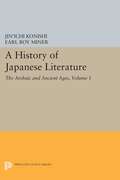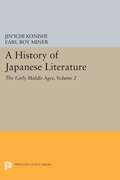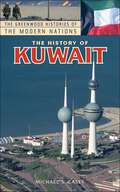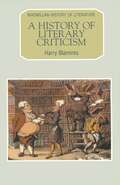- Table View
- List View
A History of Icelandic Literature
by Stefán EinarssonStefán Einarsson covers almost a thousand years of Icelandic literature in tracing the influence of the sagas and eddic poems. The book begins with background on Icelandic literature, outlining its literary roots in Scandinavia. Following this, Einarsson provides a thorough survey of Icelandic literature through the 1950s.
A History of Icelandic Literature
by Stefán EinarssonOriginally published in 1957. Stefán Einarsson covers almost a thousand years of Icelandic literature in tracing the influence of the sagas and eddic poems. The book begins with background on Icelandic literature, outlining its literary roots in Scandinavia. Following this, Einarsson provides a thorough survey of Icelandic literature through the 1950s.
A History of Icelandic Literature
by Stefán EinarssonOriginally published in 1957. Stefán Einarsson covers almost a thousand years of Icelandic literature in tracing the influence of the sagas and eddic poems. The book begins with background on Icelandic literature, outlining its literary roots in Scandinavia. Following this, Einarsson provides a thorough survey of Icelandic literature through the 1950s.
The History of Illiteracy in the Modern World Since 1750
by Martyn LyonsThis Palgrave Pivot examines the history of literacy with illiterate and semi-literate people in mind, and questions the clear division between literacy and illiteracy which has often been assumed by social and economic historians. Instead, it turns the spotlight on all those in-between, the millions who had some literacy skills, but for whom reading and writing posed difficulties. Its main focus is on those we have often labelled ‘illiterates’, rather than those who enjoyed full competence in reading and writing in modern society. In offering a historical perspective on the ‘problem’ of illiteracy in the modern world, it also questions some enduring myths surrounding the phenomenon. This book therefore has a revisionist objective: it intends to challenge conventional wisdom about illiteracy.
History of Iranian Literature
by J. RypkaSome justification seems to be necessary for the addition of yet another History of Iranian Literature to the number of those already in existence. Such a work must obviously contain as many novel features as possible, so that a short explanation of what my collaborators and I had in mind when planning the book is perhaps not superfluous. In the first place our object was to present a short summary of the material in all its aspects, and secondly to review the subject from the chronological, geo graphical and substantial standpoints - all within the compass of a single volume. Such a scheme precludes a formal and complete enumeration of names and phenom ena, and renders all the greater the obligation to accord most prominence to matters deemed to be of greatest importance, supplementing these with such figures and forms as will enable an impression to be gained of the period in question - all this is far as possible in the light of the most recent discoveries. A glance at the table of contents will suffice to give an idea of the multifarious approach that has been our aim. We begin at the very first traces of evidence bearing on our subject and continue the narrative up to the present day. Geographically the book embraces Iran and its neighbouring countries, while it should be remarked that Iranian literature in its fullest sense also includes Indo-Persian and Judeo-Persian works.
A History of Japanese Literature, Volume 1: The Archaic and Ancient Ages (PDF)
by Jin'Ichi Konishi Earl Roy Miner Nicholas TeeleThis book, which covers the period from preliterate times to the beginning of the tenth century, is the first of five proposed volumes that will give an account of Japanese literature from its beginnings to the death of the modern novelist Mishima.Originally published in 1984.The Princeton Legacy Library uses the latest print-on-demand technology to again make available previously out-of-print books from the distinguished backlist of Princeton University Press. These editions preserve the original texts of these important books while presenting them in durable paperback and hardcover editions. The goal of the Princeton Legacy Library is to vastly increase access to the rich scholarly heritage found in the thousands of books published by Princeton University Press since its founding in 1905.
A History of Japanese Literature, Volume 2: The Early Middle Ages (PDF)
by Jin'Ichi Konishi Earl Roy Miner Nicholas TeeleThe second of live volumes planned to give a systematic account of Japanese literature from its beginnings to the death of the modern novelist Mishima, this book establishes the character of the literature of the early Middle Ages, from the ninth to the mid-twelfth century.Originally published in 1986.The Princeton Legacy Library uses the latest print-on-demand technology to again make available previously out-of-print books from the distinguished backlist of Princeton University Press. These editions preserve the original texts of these important books while presenting them in durable paperback and hardcover editions. The goal of the Princeton Legacy Library is to vastly increase access to the rich scholarly heritage found in the thousands of books published by Princeton University Press since its founding in 1905.
A History of Japanese Literature, Volume 3: The High Middle Ages (PDF)
by Jin'Ichi Konishi Earl Roy Miner Aileen Gatten Nicholas TeeleIn this third of five volumes tracing the history of Japanese literature through Mishima Yukio, Jin'ichi Konishi portrays the high medieval period. Here he continues to examine the influence of Chinese literature on Japanese writers, addressing in particular reactions to Sung ideas, Zen Buddhism, and the ideal of literary vocation, michi. This volume focuses on three areas in which Konishi has long made distinctive contributions: court poetry (waka), featuring twelfth-and thirteenth-century works, especially those of Fujiwara Teika (1162-1241); standard linked poetry (renga), from its inception to its full harvest in the work of Sogi (1421-1502); and the theatrical form noh, including the work of Zeami (ca. 1365-1443) and Komparu Zenchiku (1405-?). The author also considers prose narrative and popular song.Originally published in 1991.The Princeton Legacy Library uses the latest print-on-demand technology to again make available previously out-of-print books from the distinguished backlist of Princeton University Press. These editions preserve the original texts of these important books while presenting them in durable paperback and hardcover editions. The goal of the Princeton Legacy Library is to vastly increase access to the rich scholarly heritage found in the thousands of books published by Princeton University Press since its founding in 1905.
The History of Knowledge (Elements in Historical Theory and Practice)
by null Johan Östling null David Larsson HeidenbladThis Element provides a pedagogical overview of the history of knowledge, including its main currents, distinguishing ideas, and key concepts. However, it is not primarily a state-of-the-art overview but rather an argumentative contribution that seeks to push the field in a certain direction – towards studying knowledge in society and knowledge in people's lives. Hence, the history of knowledge envisioned by the authors is not a rebranding of the history of science and intellectual history, but rather a reinvigoration of social and cultural history. This implies that many different forms of knowledge should be objects of study. By drawing on ongoing research from all across the world dealing with different time periods and problems, the authors demonstrate that the history of knowledge can enrich our understanding of past societies. This title is also available as Open Access on Cambridge Core.
The History of Kuwait (The Greenwood Histories of the Modern Nations)
by Michael S. CaseyThe tiny country of Kuwait grabbed the world's attention during the Gulf War, during which its natural petroleum resource became the envy of its neighboring country of Iraq. But Kuwait's history goes back long before any oil was discovered, back to Mesopotamian settlements as early as 3000 BCE. Ideal for high school students as well as general readers, History of Kuwait offers a comprehensive look at how such a small country could, essentially, rule the world with just one natural resource. From sheikhdom to British protectorate to independence to invasion, Kuwait's history is long and rich with culture. Michael S. Casey demonstrates how this Middle Eastern gem has grown throughout the centuries.
The History of Lady Louisa Stroud, and the Honourable Miss Caroline Stretton: by Phebe Gibbes (Chawton House Library: Women's Novels)
by Michael J. FranklinThis new edition of the British epistolary novel The History of Lady Louisa Stroud, and the Honourable Miss Caroline Stretton examines the theme of female agency, and is an excellent example of women's writing in the eighteenth-century. The relationships of the author, Phebe Gibbes, with the East India Company, The London Magazine, ‘The Benevolent Society’, and the Royal Literary Society provide rich avenues for research. Accompanied by a new introduction and editorial commentary, this text will be of great interest to students of literary history and women's writing.
The History of Lady Louisa Stroud, and the Honourable Miss Caroline Stretton: by Phebe Gibbes (Chawton House Library: Women's Novels)
by Mike FranklinThis new edition of the British epistolary novel The History of Lady Louisa Stroud, and the Honourable Miss Caroline Stretton examines the theme of female agency, and is an excellent example of women's writing in the eighteenth-century. The relationships of the author, Phebe Gibbes, with the East India Company, The London Magazine, ‘The Benevolent Society’, and the Royal Literary Society provide rich avenues for research. Accompanied by a new introduction and editorial commentary, this text will be of great interest to students of literary history and women's writing.
The History of Lady Sophia Sternheim (Pickering Women's Classics)
by J CollyerThe best-known novel of Sophie von La Roche, a German 18th-century woman writer. The plot reflects typical 18th-century concerns: the value of sentiment and the importance of virtue in attaining a good life. The publication of this novel reflects a recent revival of interest in the author.
The History of Lady Sophia Sternheim (Pickering Women's Classics)
by J CollyerThe best-known novel of Sophie von La Roche, a German 18th-century woman writer. The plot reflects typical 18th-century concerns: the value of sentiment and the importance of virtue in attaining a good life. The publication of this novel reflects a recent revival of interest in the author.
The History of Late Modern Englishes: An Activity-based Approach (Learning about Language)
by Keith JohnsonThe History of Late Modern Englishes provides an accessible and student-friendly introduction to the history of the English language from the beginning of the eighteenth century up until the present day. Taking an activity-based approach, this text ensures that students learn by engaging with the fascinating evolution of this language rather than by simply reading about it. The History of Late Modern Englishes: • Covers the development of Englishes around the world, not only in the British Isles, but also in the United States, Canada, India, Singapore, Australia, New Zealand, and Melanesia, as well as in other countries around the world where English is used as a lingua franca; • Accommodates the needs of both native and non-native speakers of English, with helpful features such as a glossary of key terms and questions to guide the reader through the book; • Includes activity sections and discussion points to help students engage with the text; • Is accompanied by e-resources which include further activities and additional coverage of points of interest in the book. Written by an experienced teacher and author, this book is an essential course textbook for any module on the history of English and the perfect accompaniment to the author’s own The History of Early English.
The History of Late Modern Englishes: An Activity-based Approach (Learning about Language)
by Keith JohnsonThe History of Late Modern Englishes provides an accessible and student-friendly introduction to the history of the English language from the beginning of the eighteenth century up until the present day. Taking an activity-based approach, this text ensures that students learn by engaging with the fascinating evolution of this language rather than by simply reading about it. The History of Late Modern Englishes: • Covers the development of Englishes around the world, not only in the British Isles, but also in the United States, Canada, India, Singapore, Australia, New Zealand, and Melanesia, as well as in other countries around the world where English is used as a lingua franca; • Accommodates the needs of both native and non-native speakers of English, with helpful features such as a glossary of key terms and questions to guide the reader through the book; • Includes activity sections and discussion points to help students engage with the text; • Is accompanied by e-resources which include further activities and additional coverage of points of interest in the book. Written by an experienced teacher and author, this book is an essential course textbook for any module on the history of English and the perfect accompaniment to the author’s own The History of Early English.
History of Linguistics Vol III: Renaissance and Early Modern Linguistics
by Giulio C. LepschyTheHistory of Linguistics, to be published in five volumes, aims to provide the reader with an authoritative and comprehensive account of the attitudes to language prevailing in different civilizations and in different periods by examining the very varied development of linguistic thought in the specific social, cultural and religious contexts involved. Issues discussed include the place of language in education, variation and prestige, and approaches to lexical and grammatical description. The authors of the individual chapters are specialists who have analysed the primary sources and produced original syntheses by exploring the linguistic interests and assumptions of particular cultures in their own terms, without seeking to reinterpret them as contributions towards the development of contemporary western conceptions of linguistic science.The third volume of the History of Linguistics covers the Renaissance and the Early Modern Period. The chapter on the Renaissance (15th and 16th centuries), examines the study of Latin in both the new Humanist and rationalist traditions, along with the foundations of vernacular grammar in the study of Romance, Germanic and Slavic. The chapter on the Early Modern Period (17th and 18th centuries) presents the study of language in its philosophical context (Bacon, Port-Royal, Hobbes, Locke, Leibniz, the Enlightenment), as well as the accumulation of data which led to the foundation of Comparative Philology in the 19th century.
History of Linguistics Vol III: Renaissance and Early Modern Linguistics
by Giulio C. LepschyTheHistory of Linguistics, to be published in five volumes, aims to provide the reader with an authoritative and comprehensive account of the attitudes to language prevailing in different civilizations and in different periods by examining the very varied development of linguistic thought in the specific social, cultural and religious contexts involved. Issues discussed include the place of language in education, variation and prestige, and approaches to lexical and grammatical description. The authors of the individual chapters are specialists who have analysed the primary sources and produced original syntheses by exploring the linguistic interests and assumptions of particular cultures in their own terms, without seeking to reinterpret them as contributions towards the development of contemporary western conceptions of linguistic science.The third volume of the History of Linguistics covers the Renaissance and the Early Modern Period. The chapter on the Renaissance (15th and 16th centuries), examines the study of Latin in both the new Humanist and rationalist traditions, along with the foundations of vernacular grammar in the study of Romance, Germanic and Slavic. The chapter on the Early Modern Period (17th and 18th centuries) presents the study of language in its philosophical context (Bacon, Port-Royal, Hobbes, Locke, Leibniz, the Enlightenment), as well as the accumulation of data which led to the foundation of Comparative Philology in the 19th century.
History of Linguistics Volume I: The Eastern Traditions of Linguistics
by Giulio C. LepschyThis comprehensive history of linguistics is part of a 5 volume set. Together, the volumes examine the social, cultural and religious functions of language, its place in education, the prestige attached to different varieties of language, and the presentation of lexical and grammatical descriptions. They explore the linguistic interests and assumptions of individual cultures in their own terms, without trying to transpose and reshape them into the context of contemporary ideas of what the scientific study of language ought to be. The authors of individual chapters are all specialists who have been able to analyse the primary sources, and so produce original syntheses which offer an authoritative view of the different traditions and periods. Volime One examines the developments of Chinese linguistics, Indian grammatical tradition, the linguistic interests of the Near East, the Hebrew tradition, and the Arabic grammatical system of the Middle Ages.
History of Linguistics Volume I: The Eastern Traditions of Linguistics
by Giulio C. LepschyThis comprehensive history of linguistics is part of a 5 volume set. Together, the volumes examine the social, cultural and religious functions of language, its place in education, the prestige attached to different varieties of language, and the presentation of lexical and grammatical descriptions. They explore the linguistic interests and assumptions of individual cultures in their own terms, without trying to transpose and reshape them into the context of contemporary ideas of what the scientific study of language ought to be. The authors of individual chapters are all specialists who have been able to analyse the primary sources, and so produce original syntheses which offer an authoritative view of the different traditions and periods. Volime One examines the developments of Chinese linguistics, Indian grammatical tradition, the linguistic interests of the Near East, the Hebrew tradition, and the Arabic grammatical system of the Middle Ages.
History of Linguistics Volume II: Classical and Medieval Linguistics
by Giulio C. LepschyThis comprehensive history of linguistics is part of a 5 volume set. Together, the volumes examine the social, cultural and religious functions of language, its place in education, the prestige attached to different varieties of language, and the presentation of lexical and grammatical descriptions. They explore the linguistic interests and assumptions of individual cultures in their own terms, without trying to transpose and reshape them into the context of contemporary ideas of what the scientific study of language ought to be. The authors of individual chapters are all specialists who have been able to analyse the primary sources, and so produce original syntheses which offer an authoritative view of the different traditions and periods. Volume Two examines the Greek, Roman and Medieval European traditions, which between them developed the grammatical and syntactical models which form the basis of our inherited linguistic assumptions.
History of Linguistics Volume II: Classical and Medieval Linguistics
by Giulio C. LepschyThis comprehensive history of linguistics is part of a 5 volume set. Together, the volumes examine the social, cultural and religious functions of language, its place in education, the prestige attached to different varieties of language, and the presentation of lexical and grammatical descriptions. They explore the linguistic interests and assumptions of individual cultures in their own terms, without trying to transpose and reshape them into the context of contemporary ideas of what the scientific study of language ought to be. The authors of individual chapters are all specialists who have been able to analyse the primary sources, and so produce original syntheses which offer an authoritative view of the different traditions and periods. Volume Two examines the Greek, Roman and Medieval European traditions, which between them developed the grammatical and syntactical models which form the basis of our inherited linguistic assumptions.
History of Linguistics, Volume IV: Nineteenth-Century Linguistics (Longman Linguistics Library)
by Anna Morpurgo Davies Giulio C. LepschyThe History of Linguistics, to be published in five volumes, aims to provide the reader with an authoritative and comprehensive account of the attitudes to language prevailing in different civilizations and in different periods by examining the very varied development of linguistic thought in the specific social, cultural and religious contexts involved. Issues discussed include the place of language in education, variation and prestige, and approaches to lexical and grammatical description. The authors of the individual chapters are specialists who have analysed the primary sources and produced original syntheses by exploring the linguistic interests and assumptions of particular cultures in their own terms, without seeking to reinterpret them as contributions towards the development of contemporary western conceptions of linguistic science.In Volume IV: Nineteenth Century Linguistics, Anna Morpurgo Davies shows how linguistics came into its own as an independent discipline separated from philosophical and literary studies and enjoyed a unique intellectual and institutional success tied to the research ethos of the new universities, until it became a model for other humanistic subjects which aimed at 'scientific status'. The linguistics of the nineteenth century abandons earlier theoretical discussions in favour of a more empirical and historical approach using new methods to compare languages and to investigate their history. The great achievement of this period is the demonstration that languages such as Sanskrit , Latin and English are related and derive from a parent language which is not attested but can be reconstructed. This book discusses in detail the theories developed and the individual findings obtained. In contrast with earlier historiographical trends it denies that the new approach originated entirely from German Romanticism, and highlights a form of continuity with the eighteenth century, while stressing that a deliberate break took place round the 1830s. By the end of the century the results of comparative and historical linguistics had been generally accepted, but it soon became clear that a historical approach could not by itself solve all questions that it raised. At this point the new interest in description and theory which characterizes the twentieth century began to gain prominence.
History of Linguistics, Volume IV: Nineteenth-Century Linguistics (Longman Linguistics Library)
by Anna Morpurgo Davies Giulio C. LepschyThe History of Linguistics, to be published in five volumes, aims to provide the reader with an authoritative and comprehensive account of the attitudes to language prevailing in different civilizations and in different periods by examining the very varied development of linguistic thought in the specific social, cultural and religious contexts involved. Issues discussed include the place of language in education, variation and prestige, and approaches to lexical and grammatical description. The authors of the individual chapters are specialists who have analysed the primary sources and produced original syntheses by exploring the linguistic interests and assumptions of particular cultures in their own terms, without seeking to reinterpret them as contributions towards the development of contemporary western conceptions of linguistic science.In Volume IV: Nineteenth Century Linguistics, Anna Morpurgo Davies shows how linguistics came into its own as an independent discipline separated from philosophical and literary studies and enjoyed a unique intellectual and institutional success tied to the research ethos of the new universities, until it became a model for other humanistic subjects which aimed at 'scientific status'. The linguistics of the nineteenth century abandons earlier theoretical discussions in favour of a more empirical and historical approach using new methods to compare languages and to investigate their history. The great achievement of this period is the demonstration that languages such as Sanskrit , Latin and English are related and derive from a parent language which is not attested but can be reconstructed. This book discusses in detail the theories developed and the individual findings obtained. In contrast with earlier historiographical trends it denies that the new approach originated entirely from German Romanticism, and highlights a form of continuity with the eighteenth century, while stressing that a deliberate break took place round the 1830s. By the end of the century the results of comparative and historical linguistics had been generally accepted, but it soon became clear that a historical approach could not by itself solve all questions that it raised. At this point the new interest in description and theory which characterizes the twentieth century began to gain prominence.
A History of Literary Criticism (Macmillan History of Literature)
by Harry BlamiresThe author traces the course of literary criticism from its foundations in classical and medieval precepts to the theorising of the present day. He explores the texts which have been milestones in the history of critical thought, placing them firmly in the context of their time.















